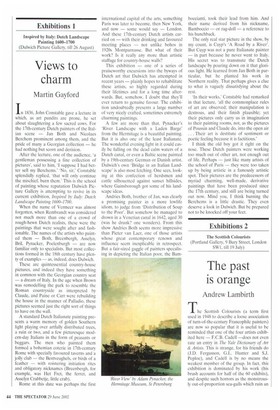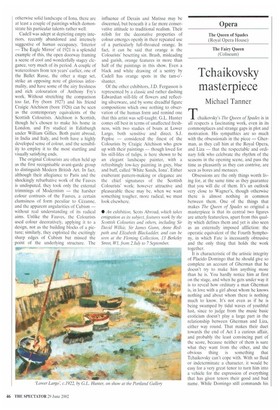The past is orange
Andrew Lamb irth
The Scottish Colourists (a term first used in 1948 to describe a loose association of turn-of-the-century Francophile painters) are now so popular that it is useful to be reminded that one of the four artists exhibited here — F.C.B. Cadell —does not even rate an entry in The Yale Dictionary of Art & Artists. This is strange, for his friends do (J.D. Fergusson, G.L. Hunter and S.J. Peploe), and Cadell is by no means the weakest member of the group. In fact, this exhibition is dominated by his work (his brush accounts for half of the 60 exhibits), and despite such horrors as the monstrously out-of-proportion sea-gulls which ruin an
otherwise solid landscape of Iona, there are at least a couple of paintings which demonstrate his particular talents rather well.
Cade11 was adept at depicting empty interiors, recently abandoned and intensely suggestive of human occupancy. 'Interior — The Eagle Mirror' of 1921 is a splendid example of this, the open doorway framing a scene of cool and wonderfully stagey elegance, very much of its period. A couple of watercolours from ten years' earlier, one of the Ballet Russe, the other a stage set, strike an opposing note of glorious informality, and have some of the airy freshness and rich colouration of Anthony Fry's work. Without stretching the comparison too far, Fry (born 1927) and his friend Craigie Aitchison (born 1926) can be seen as the contemporary equivalents of the Scottish Colourists. Aitchison is Scottish, though he's chosen to make his home in London, and Fry studied in Edinburgh under William Gillies. Both paint abroad, in India and Italy, and both have a highly developed sense of colour, and the sensibility to employ it to the most startling and visually satisfying ends.
The original Colourists are often held up as the first recognisable avant-garde group to distinguish Modern British Art. In fact, although their allegiance to Paris and the shockingly rebarbative work of the Fauves is undisputed, they took only the external trimmings of Modernism — the harsher colour contrasts of the Fauves, a certain clumsiness of form peculiar to Cezanne, and the apparent angularities of Cubism — without real understanding of its radical aims. Unlike the Fauves, the Colourists used colour decoratively, applying it to a design, not as the building blocks of a picture; similarly, they exploited the excitingly sharp edges of Cubism but missed the point of the underlying structure. The influence of Derain and Matisse may be discerned, but beneath it a far more conservative attitude to traditional realism. Their relish for the decorative properties of colour emerges openly in their repeated use of a particularly full-throated orange. In fact, it can be said that orange is the Colourists' besetting sin. Brash, misleading and garish, orange features in more than half of the paintings in this show. Even a black and white drawing of a sentry by Cade11 has orange spots in the tam-o'shanter.
Of the other exhibitors, J.D. Fergusson is represented by a classic and rather dashing Edwardian still-life of flowers and reflecting silverware, and by some dreadful figure compositions which owe nothing to observation of the human form and remind one that this artist was self-taught. G.L. Hunter comes off best in terms of unaffected freshness, with two studies of boats at Lower Largo, both sensitive and direct. S.J. Peploe — considered the finest of the Colourists by Craigie Aitchison who grew up with their paintings — though loved for his still-lifes of tulips, is here shown to be an elegant landscape painter, with a refreshingly low-key painting in grey, blue and buff, called 'White Sands, Iona'. Either exuberant pattern-making or elegance are the chief signatures of the Scottish Colourists' work; however attractive and pleasurable these may be, when we want something tougher, more radical, we must look elsewhere.
• An exhibition, Scots Abroad, which takes emigration as its subject, features work by the Scottish Colourists and others, including Sir David Wilkie, Sir James Gunn, Anne Redpath and Elizabeth Blackadder, and can be seen at the Fleming Collection, 13 Berkeley Street, WI, from 2 July to 7 September.



































































 Previous page
Previous page